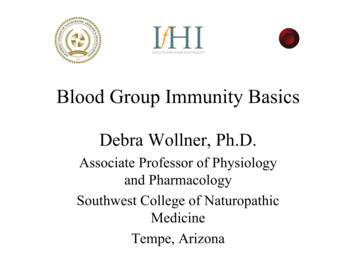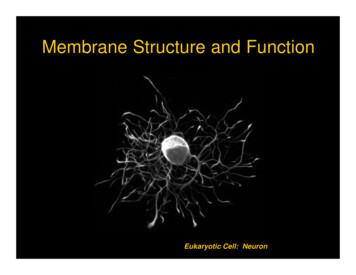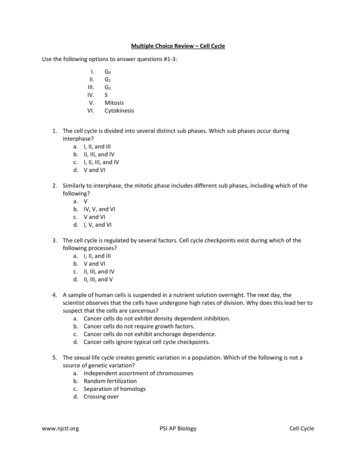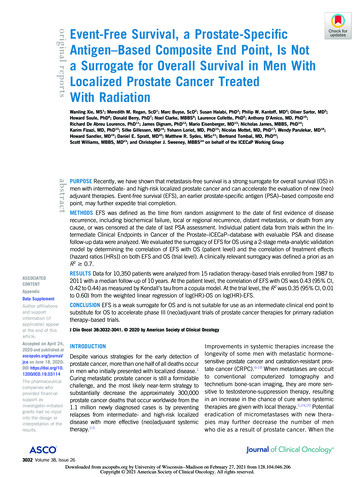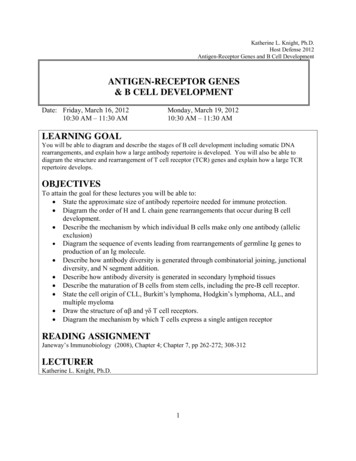
Transcription
Katherine L. Knight, Ph.D.Host Defense 2012Antigen-Receptor Genes and B Cell DevelopmentANTIGEN-RECEPTOR GENES& B CELL DEVELOPMENTDate: Friday, March 16, 201210:30 AM – 11:30 AMMonday, March 19, 201210:30 AM – 11:30 AMLEARNING GOALYou will be able to diagram and describe the stages of B cell development including somatic DNArearrangements, and explain how a large antibody repertoire is developed. You will also be able todiagram the structure and rearrangement of T cell receptor (TCR) genes and explain how a large TCRrepertoire develops.OBJECTIVESTo attain the goal for these lectures you will be able to: State the approximate size of antibody repertoire needed for immune protection. Diagram the order of H and L chain gene rearrangements that occur during B celldevelopment. Describe the mechanism by which individual B cells make only one antibody (allelicexclusion) Diagram the sequence of events leading from rearrangements of germline Ig genes toproduction of an Ig molecule. Describe how antibody diversity is generated through combinatorial joining, junctionaldiversity, and N segment addition. Describe how antibody diversity is generated in secondary lymphoid tissues Describe the maturation of B cells from stem cells, including the pre-B cell receptor. State the cell origin of CLL, Burkitt’s lymphoma, Hodgkin’s lymphoma, ALL, andmultiple myeloma Draw the structure of αβ and γδ T cell receptors. Diagram the mechanism by which T cells express a single antigen receptorREADING ASSIGNMENTJaneway’s Immunobiology (2008), Chapter 4; Chapter 7, pp 262-272; 308-312LECTURERKatherine L. Knight, Ph.D.1
Katherine L. Knight, Ph.D.Host Defense 2012Antigen-Receptor Genes and B Cell DevelopmentCONTENT SUMMARYIntroductionGenetic basis for the antibody repertoireI. Germline organization of Ig genesThree groups of genes; κ,λ, and H chainV, D and J gene segmentsCκ and CH region genesII. Ig gene rearrangements - basic featuresB-cell developmentOrder of rearrangementsHeavy chain: DJ, VDJLight chain: VJProB, PreB, Immature B and Mature B cellsAllelic exclusion - only one VH and one VL rearranged/B cellMechanism of Ig gene rearrangementConserved heptamer/nonamer (RSS) recognition sequencesMembrane IgM vs. secreted IgMSurface IgM and IgDIIII. Generation of Antibody Diversity in bone marrowCombinatorial joining of V, D and J gene segmentsJunctional diversity- N-region addition and imprecise joiningCombinations of H and L chain proteinsSelection against self-reactive B cellsIV. Generation of antibody diversity in secondary lymphoid tissuesSomatic mutationV. B-lineage tumors: Leukemia and lymphomaChromosomal translocationsVI. T cell antigen receptorStructureGene organization and rearrangement2
Katherine L. Knight, Ph.D.Host Defense 2012Antigen-Receptor Genes and B Cell DevelopmentINTRODUCTIONProblem: One can estimate that an individual needs to be able to make antibodies to recognize about onemillion epitopes. What is the genetic basis for being able to generate so may different antibodies?Major rule of antibody synthesis: A single B cell makes only one kind of antibody specificity (one VHand one VL), i.e., allelic exclusion occurs. Also, a single plasma cell makes only one kind of antibody;i.e., 1 kind of H chain & 1 kind of L chain; B cells may violate this rule & synthesize two or more heavychain isotypes simultaneously for the cell surface, eg. IgM and IgD.I.GERMLINE ORGANIZATION OF IMMUNOGLOBULIN GENESThree groups of Genes: κ, λ and H ChainThe genes for the immunoglobulin polypeptide chains (and for the T-cell receptor chains)are split, Ig genes undergo a process of somatic DNA recombination (rearrangement)during B cell ontogeny.Each of the 3 gene families, the kappa light chain family, the lambda light chain familyand the heavy chain family can be divided into V-region genes and C-region genes. Theκ, λ and H chains are located on separate chromosomes. Each set of genes, κ, λ andheavy chain, has a similar basic organization.A. V, D and J Gene SegmentsThe Ig heavy and light chain loci are composed of multiple genes that give rise to the Vand C regions of the proteins, separated by stretches of non-coding DNA. At the 5'end of each Ig locus are the V region exons, each about 300 base-pairs (bp) long,separated from one another by non-coding DNA of varying lengths. Downstream of theV genes are additional coding sequences, 30 to 50 bp long, which make up the joining(J) segments and, in the H chain locus only, the diversity (D) segments. The J and Dgene segments code for the carboxy terminal ends of the V regions, including the thirdhypervariable (complementarily-determining) regions of antibody molecules. Thus, inan Ig light chain protein (κ or λ), the variable region is encoded by the V and J exons and3
Katherine L. Knight, Ph.D.Host Defense 2012Antigen-Receptor Genes and B Cell Developmentthe constant region by a C exon. In the heavy chain protein, the variable region isencoded by the V, D, and J exons. The constant region of the protein is derived from themultiple C exons and, for membrane-associated heavy chains, the exons encoding thetransmembrane and cytoplasmic domains.B. C Region GenesAt varying distances 3' of the V genes are the C region genes. In both mouse and man,the κ light chain locus and a single Cκ gene and the genes for heavy chain C regions (CH)of different isotypes are arranged in a tandem array. Each heavy chain C region geneactually consists of three to four exons (each similar in size to a V region exon) that makeup the complete C region, and smaller exons that code for the carboxy terminaltransmembrane (TM) and cytoplasmic domains of the heavy chains.II.IMMUNOGLOBULIN GENE REARRANGEMENTS - BASIC FEATUREAll cells except B-lineage, including plasma cells contain Ig genes inthe germline configuration. The Ig genes are expressed only in B-lineage cells.Rearrangements of Ig genes are the essential first steps in the production of antibodies.A.B Cell DevelopmentOrder of Ig gene rearrangement and B cell developmentDNA rearrangements occur in a precise order and occur independent of antigenstimulation.1.Heavy chain - DJ. The first Ig gene rearrangement involves the heavy chainlocus and leads to joining of one D and one J gene segment with deletion of the4
Katherine L. Knight, Ph.D.Host Defense 2012Antigen-Receptor Genes and B Cell Developmentintervening DNA.2.Heavy chain - VDJ. Following the DJ rearrangement, one of the many V genesis joined to the DJ complex, giving rise to a rearranged VDJ gene. At this stage,all D segments 5' of the rearranged D are also deleted. This VDJ recombinationoccurs only in cells committed to become B lymphocytes and is a critical controlpoint in Ig expression because only the rearranged V gene is subsequentlytranscribed. The C region genes remain separated from this VDJ complex by anintron.3.Light chain - VJ. The next somatic DNA recombination involves a light chainlocus. One V segment is joined to one J segment, forming a VJ complex, whichremains separated from the C region by an intron, and this gives rise to theprimary RNA transcript. Splicing of the intron from the primary transcript joinsthe C gene to the VJ complex, forming an mRNA that is translated to produce theκ protein. The light chain assembles with the previously synthesized μ to formthe complete membrane IgM molecule, which is expressed on the cell surface,and the cell is now the immature B lymphocyte.ProB Cells: These cells are precursors of PreB cells. They have IgH DJ gene rearrangementsand no light chain gene rearrangements.Pre B Cells: All B lymphocytes arise in the bone marrow from a stem cell that does notproduce Ig. The earliest cell type that synthesizes a detectable Ig gene product containscytoplasmic -heavy chains composed of variable (V) and constant (C) regions. Thiscell is called the pre-B lymphocyte and is found only in hematopoietic tissues, such asthe bone marrow and fetal liver. The pre-B receptor is comprised of surrogate lightchain, -chain, Ig and Ig Immature B Cells: At the next identifiable stage in B cell maturation, or λ light chainsare also produced. These associate with μ heavy chains and then the assembled IgM5
Katherine L. Knight, Ph.D.Host Defense 2012Antigen-Receptor Genes and B Cell Developmentmolecules are expressed on the cell surface, where they function as specific receptors forantigens. IgM-bearing B cells that are recently derived from bone marrow precursors arecalled immature B lymphocytes because they do not proliferate and differentiate inresponse to antigens. Once a B cell expresses a complete heavy or light chain, it cannotproduce another heavy or light chain containing a different V region.Mature B Cells: Having acquired a complete Ig and, therefore, an antigen specificity, Bcells migrate out of the bone marrow and can be found in the peripheral circulation andlymphoid tissues. They continue to mature, even in the absence of antigenic simulation.Mature B cells co-express μ and δ heavy chains in association with the original κ or λlight chain and, therefore, produce both membrane IgM and IgD. Both classes ofmembrane Ig have the same V region and hence the same antigen specificity. Such cellsare responsive to antigens.B. Allelic Exclusion: Only one IgH and one IgL allele are productively rearranged.Each B cell clone and its progeny are specific for only one antigenic determinant. It is,therefore, necessary for each B cell to express only one set of Ig heavy and light chain Vgenes throughout its life. This occurs because only one functional heavy chain VDJ andone functional VJ gene rearrangement occur in each cell. The expression of only oneallele in a cell is termed allelic exclusion.C. Mechanism of Ig gene rearrangement Conserved recognition sequences6
Katherine L. Knight, Ph.D.Host Defense 2012Antigen-Receptor Genes and B Cell DevelopmentThe recombination of V, D and J gene segments is mediated by specific DNArecognition sequences (RSS) located in the intervening DNA 3' of each V exon and 5' ofeach J segment and flanking both sides of each D segment . The RSS are highlyconserved stretches of seven or nine nucleotides separated by non-conserved 12 or 23nucleotide spacers. In a light chain gene, each heptamer or nonamer adjacent to a V exonrecognizes a complementary stretch adjacent to a J exon. This allows recombinase tobring the two exons together, forming a loop of intervening DNA.Enzymes then excise the intervening DNA in this loop and anneal the ends of the V and Jexons. Recombination is mediated by recombinase enzymes RAG1 and RAG2. Not allrearrangements are functional. The junctions are in CDR3.Membrane IgM vs. Secreted IgM : Secreted and membrane forms of -chain result from alternativeRNA splicing7
Katherine L. Knight, Ph.D.Host Defense 2012Antigen-Receptor Genes and B Cell DevelopmentCo-expression of membrane IgM and membrane IgD on B cells: IgM and IgD on a given Bcell have the same idiotype (VH VL). Given that one cell makes only one antibody, how can μ andδ heavy chains be produced simultaneously by the same B cell? The answer is, and chains with thesame VH domain result from alternative splicing of primary transcripts (nuclear RNA).III.GENERATION OF ANTIBODY DIVERSITY IN BONE MARROWA.Combinatorial Joining of V, D and J Gene SegmentsThe germline contains multiple germline VH and VL genes that have different sequencesand produce Ig molecules with different specificities. D and J gene segments alsocontribute to diversity.The somatic recombination of Ig DNA participates in the generation of antibody diversityin several ways. The combinatorial associations of different V, D, and J gene segmentslead to a large potential for generating different antibody specificities. The maximumpossible number of combinations is the product of the number of V, D (if present), and Jgene segments at each locus. Every clone of B cells and its progeny express a uniquecombination of V, D, and J genes.Even the same set of germline V, D, and J gene segments can generate different aminoacid sequences at the junctions. This junctional diversity can arise from imprecisejoining or N-region addition.8
Katherine L. Knight, Ph.D.Host Defense 2012Antigen-Receptor Genes and B Cell DevelopmentB.Imprecise joining: or imprecise DNA rearrangement occurs because nucleotidesequences at the 3' end of a light chain V gene segment and the 5' end of a J gene segmentor at the ends of V, D, and J gene segments in a heavy chain can each recombine at anyof several nucleotides in the germline sequence.C.N-region addition: Nucleotides, called N sequences, which are not present in thegermline, can be added to the junctions of rearranged VDJ genes during rearrangement.This addition of new nucleotides is a random process mediated by an enzyme calledterminal deoxyribonucleotide transferase (TdT).Because of junctional diversity (due to imprecise joining and N-region addition), the number ofdifferent amino acid sequences present in CDR3 of antibody molecules is much greater than thenumber of germline V and D segments present in the genome (Table 1).D.Combinations of H and L Chain ProteinsIn addition to these mechanisms operative at the level of Ig genes, the combination ofdifferent H and L chain proteins also contributes to diversity because the V region ofeach chain participates in antigen recognition.Table 1. Mechanisms Contributing to the Generation of Antibody diversity in the HumanGermline genesV gene segmentsJ segmentsD segmentsCombinatorial joiningV x J (X D)H-L chain associationsHx H 40625405030406,0002001201.2 x 106What happens to B lineage cells in the bone marrow that have non-functional V(D)J generearrangements or that express self-reactive antibody?B cells with non-functional V(D)J genes are deleted. B cells with anti-self reactivity canbecome anergic, can be deleted, or they can be rescued by receptor editing.9
Katherine L. Knight, Ph.D.Host Defense 2012Antigen-Receptor Genes and B Cell DevelopmentIV.GENERATION OF ANTIBOD DIVERSITY IN SECONDARY LYMPHOIDTISSUESA.Somatic hypermutation: Changes in antigen-binding specificity as a result ofsomatic mutations in V genes can generate additional diversity.When does somatic hypermutation (diversification) occur?Pre B and early B cells utilize unmutated germline V genes.Primary antibody response utilizes mostly unmutated V genes.Secondary antibody response utilizes mostly V genes that have undergonesomatic mutation.B. The enzyme, AID, is required for somatic hypermutation. AID deficient patients have onlyIgM and the Ig genes are not somatically diversified.10
Katherine L. Knight, Ph.D.Host Defense 2012Antigen-Receptor Genes and B Cell DevelopmentV.B-LINEAGE TUMORSIndividual B-lineage cells in BM or periphery can undergo neoplastic transformation giving riseto leukemia or lymphoma.Chromosomal translocationof c-myc into the IgH locusleads to B cell tumor.B-lineage tumors11
Katherine L. Knight, Ph.D.Host Defense 2012Antigen-Receptor Genes and B Cell DevelopmentVI.T CELL ANTIGEN RECEPTORS (TCR)Most T cells have αβ TCR; 5% of T cells have γδ TCRA.STRUCTUREThe αβ TCR is a disulfide linked heteradenic of α and β chains(α 45 kD; 40 kD).-Each chain has 2 Ig - like domains; The N-Terminal domains are variable (V)regions; The C-Terminal domains are polypeptide constant regionsThe overall structure of δγ TCR is similar to αβ except that the polypeptidechains are designated γ and δ.B. GENE ORGANIZATION AND REARRANGEMENT-The overall organization of TCR genes is similar to that of Ig genes12
Katherine L. Knight, Ph.D.Host Defense 2012Antigen-Receptor Genes and B Cell Development-The V regions of α and γ chains are encoded by V and J gene segments.The V, D and J gene segments are associated with the same conserved heptamerand monomer nucleotide sequences found in Ig genes. Thus, TCR genesrearrange by the same mechanism as Ig genes.Most importantly - as in B cells, only one VDJ and one VJ gene rearrangementoccur in each T cell. Therefore, each T cell expresses a single TCR, specific forone particular antigenic determinant.Comparison of Gene Rearrangements in B and T Cells13
Katherine L. Knight, Ph.D.Host Defense 2012Antigen-Receptor Genes and B Cell DevelopmentSTUDY QUESTIONS1.Identify the approximate number of heavy chain V, D and J gene segments in the germline.2.Identify the approximate number of light chain V and J gene segments in the germline.3.Diagram the organization of germline V, D and J heavy chain gene segments and V and J lightchain gene segments. (Be sure to identify the exons and introns within each diagram).4.State the number of CH genes and their relationship to Ig subclasses.5.List the order of Ig H and L chain gene rearrangements.6.Diagram Ig H and L chain gene rearrangements.7.What is the significance of allelic exclusion and describe the mechanism responsible forgenerating allelic exclusion.8.Given a B cell with a VDJ gene rearrangement describe the fate of:1.VH gene segments upstream of the VDJ gene.2.D gene segments that were not used in the VDJ gene rearrangement.3.J gene segments downstream of the VDJ gene.9.Describe how the hepatamer/nonamer signal sequences (RSS) mediate V, D and J generearrangements.10.State the role of RNA processing in synthesis of Ig L chains.11.For the light chain genes, compare the intervening nucleic acid sequences that are lost duringDNA recombination with those lost during RNA splicing.12.Diagram the sequence of events in B cells that lead to the production of L chains; start withrearrangement of L chain genes.13.State how μ and δ H chain can arise from the same primary transcript.14.Compare the organization of TCR and Ig genes.15.Compare the mechanism of rearrangements of TCR genes and Ig genes.16.State the approximate number of antibody specificities needed for protection.17.State the approximate number of germline VH, VL, D, JH, and JL, gene segments.14
Katherine L. Knight, Ph.D.Host Defense 2012Antigen-Receptor Genes and B Cell Development18.Explain the mechanisms by which CDR3 becomes more variable than CDR1 and CDR2.23.TCompare the contribution of somatic mutation to the diversity of Ig receptors with the diversity ofcell receptors.ADDITIONAL QUESTIONSIndicate whether each of the following statements is true or false:1.Immunoglobulins are encoded by genes located on one chromosome.2.Within one immunoglobulin molecule there may be two types of light chain.3.The immunoglobulin combining site (for antigen) is contributed by the hypervariable regionswithin each of the heavy and light chain variable regions.4.IgG and IgM molecules are distinguished by differences in their heavy chain constant regionsequences.5.Myeloma proteins are the result of polyclonal B cell activation.6.V gene segments are not joined with J gene segments in cells other than lymphoid cells.7.Allelic exclusion refers to the phenomenon where only the heavy or light chain is produced bythe cell but not both.8.In pre-B cells, both heavy and light chain genes are rearranged.ANSWERS TO THE ADDITIONAL QUESTIONS1.False. Immunoglobulins are encoded by 3 gene families: for heavy chain, kappa andlambda light chains. The 3 gene families each reside on a separate chromosome.2.False. The light chains of a single antibody are identical and the heavy chains areidentical also. Therefore, one immunoglobulin may be either lambda or kappa.3.True.4.True.5.False. Myeloma proteins are homogenous and result from 1 B cell becoming concerous.6.True.15
Katherine L. Knight, Ph.D.Host Defense 2012Antigen-Receptor Genes and B Cell Development7.False. Allelic exclusion means that only one allele of each gene (H, and kappa orlambda) is expressed at the protein level - i.e., either the maternal or paternalheavy chain allele is expressed - as well as that for either kappa or lambda. Theresult of allelic exclusion is the expression by the B cell of only oneimmunoglobulin and one immunoglobulin specificity (clonal expression).8.False. Light chain genes are in germline configuration.EXAMPLES OF TEST QUESTIONS1.Somatic hypermutation is most active during:A.Differentiation of pre-b cells into mature B cellsB.Differentiation of pre-T cells into mature T cellsC.Generation of memory B cellsD.VH, D, JH gene rearrangementsE.A primary immune responseMatch the following Ig gene rearrangements with the appropriate cell type:A.DJ.gene rearrangement on one allele; VDJ gene rearrangement on the other allele;no VJ gene rearrangementB.VJ gene rearrangements on both kappa-chain alleles.C.VDJH gene rearrangement on one allele; VJL gene rearrangement on one allele.D.No VDJ, DJ or VJ Ig gene rearrangements.1. Plasma cell.2.Pre-B lymphocyte.3.T-lymphocyte.Answers to above questions: 1-C16
Katherine L. Knight, Ph.D.Host Defense 2012Antigen-Receptor Genes and B Cell Development2-A3-D17
How to Generate Millions of Ig?VHVHVLVLGermline Organization of Ig GenesIg Constant Region Genes1
Ig Gene RearrangementsIg Gene RearrangementsB Cell Developmentin Bone MarrowHSCHSC hematopoieticstem cell(CD34 )2
B cell Developmentin Bone MarrowHSCB cell Developmentin Bone MarrowAllelicExclusion3
How Does Ig GeneRearrangementOccur?Conserved Recombination RecognitionSequences for RAG-1 and RAG-2Mechanismof Ig GeneRearrangementLoop-outExcisionRe-joining4
How to ObtainSecreted IgM andMembrane IgMwith the Same VDJ region?&How to Obtain IgM and IgDwith theSame VDJ region?Ans: Alternative RNA Splicing5
Co-expression ofMembrane IgM and IgDIgMIgDGeneration of Antibody DiversityHow large a repertoire do we need?How, genetically, is such a largeantibody repertoire generated?Generation of the Antibody Repertoire1. Combinatorial V(D)J gene joining2. Junctional diversity- (imprecisejoining)3. N nucleotide addition by TdT4. Combinatorial association ofH and L chains6
Junctional Diversity During Vκ andJκ Joining (Imprecise Joining)N-Region AdditionN-RegionAdditionN-Region Addition(N-nucleotides)VHDHJHTdT (terminal deoxyribonucleotide transferase)DHVHAGCGTNJHTACGCAGN7
Mechanisms Contributing to Ab DiversityGermline GenesV gene segmentsJ segmentsD JoiningVxDxJH-L Chain Associations1.2 x 106HxκWhat if V(D)J generearrangementsare non-functional?Ans: They dieor encodeself-reactivity?Elimination of Self-reactive B cells8
A Second Chance forSelf-reactiveB cells:ReceptorEditingReceptor Editing of Anti-selfVJ gene rearrangements9
Immature B Cells LeaveBone Marrow to PeripheryPeripheryAntigenImmune Response tothe AntigenSomatic Hypermutation of Ig GenesAffinity MaturationRequired Enzyme AIDB-lineage Tumors10
B cell tumorsdeveloping fromchromosomaltranslocation ofc-myc into the IgHlocusStructuralSimilarityof TCR and IgOrganization of TCR Genes11
Rearrangement of TCR GenesT cellRearrangementExcision Circles(TRECS)Gene Rearrangements: T cells vs B cells12
Germinal Centers – Sites of SomaticHypermutationGerminal Centers Induced Duringan Immune ResponseGerminal Center Reactions1. Somatic hypermutationa. AID is required2. Development of memory B cells3. Development of plasma cells13
B Cell Developmentin Bone Marrow14
Host Defense 2012Small Group Problem Solving SessionClinical and Experimental Immunologic Assays-IHOST DEFENSESMALL GROUP PROBLEM SOLVING SESSIONCLINICAL IMMUNOLOGIC ASSAYS-ISmall Group ClassroomsLEARNING GOALUnderstanding in vitro assessment of immunologic responses that have contemporary clinicalrelevanceBACKGROUND READINGJaneway 8th: Most of the concepts are developed in the text of the Notes, Dr Knight’s lectures,and also the Letter to the Editor and a Clinical Implications of Basic Research from the NewEngland J of Medicine that are posted on the HD site.DEVELOPED BYJohn A. Robinson, M.D.Rev 11/01/20111
Host Defense 2012Small Group Problem Solving SessionClinical and Experimental Immunologic Assays-II.Active and Passive ImmunityA. Introduction1. Many life-threatening infections are caused by the release of proteintoxins by bacteria after they have infected a patient. Diphtheria andtetanus are two prime examples. A patient will be protected against thetoxin effects if specific antibodies against the toxin are present at thetime of infection.2. Protective antibodies arise during actual infection or can be induced byvaccines3. The following vignettes underscore the need to understand basicimmune responses and their timing in order to successfully treat someserious infections.4. Implementation of an immunologic treatment strategy must be basedon understanding of how specific antibody responses are induced andhow long they are effective.5. For the purposes of this Small Group, do not worry about the complexcellular interactions required for antibody formation - this comes laterbut be sure you understand the CONCEPTS of primary and secondaryimmunization and active versus passive immunizationB. The following graph illustrates the temporal sequence of antibody formation toan antigen (or infection).Fig. 1.20 The course of a typical antibody response. First encounter with an antigen produced a primary response.Antigen A introduced at time zero encounters little specific antibody in the serum. After a lag phase, antibody againstantigen A (blue) appears; its concentration rises to a plateau, and then declines. When the serum is tested for antibodyagainst another antigen, B (yellow), there is none present demonstrating the specificity of the antibody response. Whenthe animal is later challenged with a mixture of antigens A and B, a very rapid and intense secondary response to Aoccurs. This illustrates immunological memory, the ability of the immune system to make a second response to thesame antigen more efficiently and effectively, providing the host with a specific defense against infection. This is theRevmain 11/01/2011reason for giving booster injections after an initial vaccination. Note that the response to B resembles the initial orprimary response to A, as this is the first encounter of the 2animal with antigen B.
Host Defense 2012Small Group Problem Solving SessionClinical and Experimental Immunologic Assays-ICopyright: 2007From: Immunobiology, 7th edn.Author: Janeway, et alReproduced by permission of Routledge, Inc., part of the Taylor Francis GroupC. The temporal lag in appearance of specific antibody in the patient's peripheral bloodduring a primary immune response to an infectious pathogen is a critical problem. Theearly period of little, if any, significant antibody production is a time of extremevulnerability. Antibiotics provide some protection while the immune system gears up forantibody synthesis which then provides active immunity.D. The significant decline of serum antibody concentration over a 4-6 week period afteran immune stimulus emphasizes the importance of memory in adaptive immuneresponses. The memory pool of immune cells that remember the first infection prime thesystem for a rapid, specific response to the same pathogen. This is designated asecondary immune response.E. The graph also illustrates the rapidity of a secondary response to the same antigen thatthe individual had originally been vaccinated with. Not only is there is no "window" ofopportunity for organism and its toxin to escape antibody neutralization after the secondantigen exposure but serum antibody levels are maintained thereafter for a much longerperiod of time.F. Vaccines are designed to mimic active immunity that would have been triggered byan actual infection. Use of a vaccine before the actual infection provides the host with theability to respond with a rapid secondary response that abbreviates the vulnerable periodof no antibody formation during early infectionG. Modern biotechnology now provides a way for the physician to provide "instant"specific antibodies to an infected or potentially infected patient. In this case, thephysician, using epidemiologic and clinical data, must be able to predict the organismthat the patient is most likely infected with and then passively immunize the patient byinfusing the specific, premade antibody into the patient at the time of the infection. Thedrawback to passive immunization is that the duration of protection against the infectionis defined by the half-life of the infused antibody which is about 3 weeks. With a fewexceptions, no active immunization occurs (you may see an example of the exceptionlater in this exercise).H. Apply the basic concepts of primary and secondary immune responses and active andpassive immunity to the clinical examples below (You do not have to read about thespecific diseases to understand the concepts). What type of immunity, if any, is needed toRev 11/01/20113
Host Defense 2012Small Group Problem Solving SessionClinical and Experimental Immunologic Assays-Itreat the following 2 patients?1. A twenty year old on active military duty arrives at your office with a oneinch long, very superficial laceration of the forearm caused by a dog bite.The dog belonged to his neighbor and was able to be confined andobserved for clinical rabies. The real concern is whether the patient coulddie from tetanus toxin if a tetanus infection transpired. Tetanus bacteriaonly grow well in situations where there is reduced oxygen- e.g., a deeppenetrating wound , like a nail in a foot. This wound was easily cleanedand did not require sutures.2. A 23 year old mountaineer, who arrived in town only last week, shows upin the ER with a lacerated, swollen and tender swelling of the right gluteusmuscle. The wound has dirt and leafy debris embedded in it. The patientwas bitten while "escaping from an angry bear". He lived in a “holler” hisentire life and has never been to a doctor before. Knowing what you doabout tetanus from the first clinical scenario, what immunologic conceptswould have to be applied in this instance?I. Now apply your general understanding of immune responses to the following clinicalproblems.1.
Janeway's Immunobiology (2008), Chapter 4; Chapter 7, pp 262-272; 308-312 LECTURER Katherine L. Knight, Ph.D. Katherine L. Knight, Ph.D. Host Defense 2012 Antigen-Receptor Genes and B Cell Development 2 CONTENT SUMMARY Introduction Genetic basis for the antibody repertoire
